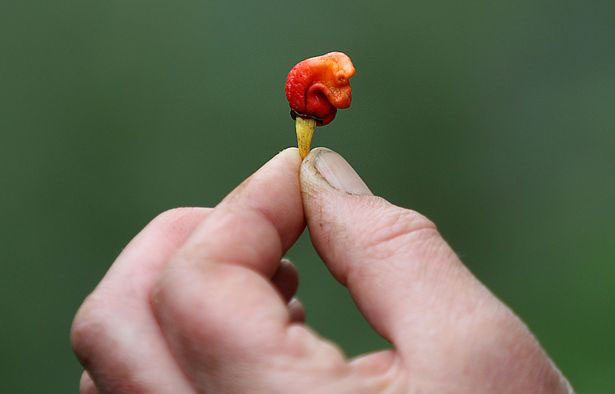 With a slight pebbly surface, diminutive size and deep orange, red and yellow folds, the latest member of horticultural royalty seems to hardly deserve a second glance. An aromatic accident of nature, it could however be considered an incendiary heat reeking missile and a hazardous combustible material in an explosive arsenal, given that it is nearly all furious fire and hissing flames like the spectacular magnesium shotgun round also called “Dragon’s Breath.”
With a slight pebbly surface, diminutive size and deep orange, red and yellow folds, the latest member of horticultural royalty seems to hardly deserve a second glance. An aromatic accident of nature, it could however be considered an incendiary heat reeking missile and a hazardous combustible material in an explosive arsenal, given that it is nearly all furious fire and hissing flames like the spectacular magnesium shotgun round also called “Dragon’s Breath.”
The world’s latest hottest chilli, revealed recently, measures a mere thumb nail and soars in at a searing minimum 2.4 million Scoville Heat Units (SHU). Harvested from a majestic metre-high “lovely looking” tree not in the tropics but in chilly North Wales, Great Britain, it was rightly named for the mythical fire-breathing beast and is now on proud display at the Chelsea Flower Show.
Ironically a valuable fruit that originated this diverse side of the planet, the chilli is locked in an “arms race” that has rapidly fired up over the last decade of global warming. The slow Caribbean has been left behind, a withering last, in a profitable international business that is booming like a belligerent “Seven Pot” “choka.” A traditional crushed concoction of smoky, roasted peppers seasoned with blackened garlic, caramelized onions and a sharp touch of fresh lime juice and green herbs, the mouth-watering “chokha” from hell survives mostly as an Indian condiment and sizzling side dish in several rural areas of Trinidad such as Barrackpore.
This southern farming town within Penal-Debe gave the world the songster Sundar Popo and the eponymous pepper which is so blistering, it made famous an entire family of the fabled fruit feted as the special “super hots.” Just a single scalding reminder is more than enough unrelenting fervour to flavour at least seven immense pots of steaming food and provide gasping gastronomic kicks equivalent to an entire enraged equine herd breathing brimstone. I have survived that nearly knockout inferno living dangerously and lurching from one blinding sensory conflagration to the next and can attest the pepper I ate from our friend’s land was so torrid it deserves a separate “17 Pot” denomination.
 According to Pepperhead.com, another distinguished member is the world-renowned pungent Trinidad “Douglah” which defies the usual colour scheme by starting out green and maturing to a unique, rich dark brown. Insanely burning insides yet staying distinctly piquant it has earned accolades for an intense chocolate/deep purple skin with many “pustules” on the surface. “You can’t go wrong with fresh, dried, or powdered ‘Douglah’ on any food,” the website raves, putting the pepper at 1,854M SHU. “When you slice a fresh Douglah open, you will immediately see pools of liquid capsaicin oils that give this chilli so much heat,” it warns.
According to Pepperhead.com, another distinguished member is the world-renowned pungent Trinidad “Douglah” which defies the usual colour scheme by starting out green and maturing to a unique, rich dark brown. Insanely burning insides yet staying distinctly piquant it has earned accolades for an intense chocolate/deep purple skin with many “pustules” on the surface. “You can’t go wrong with fresh, dried, or powdered ‘Douglah’ on any food,” the website raves, putting the pepper at 1,854M SHU. “When you slice a fresh Douglah open, you will immediately see pools of liquid capsaicin oils that give this chilli so much heat,” it warns.
Long gone are the distant days of Guyana’s glorious Tiger Teeth, Bull Nose, the crunchy Bird Pepper and the fragrant perennial favourite the tiny powerhouse Wiri Wiri. Decades ago, as a headstrong girl, I argued fiercely with my knowledgeable Mahaica mother about which of the local peppers was the best. This was a warm woman with no fear, for she would manually grind whole habaneros and whatever else showed up on her ancient stone “masala” sill or flat metate, painstakingly rolling the “lohra” or “mano” with her bare hands until the mash was a silky, smooth paste that became the base for her unforgettable sauce. Due to my love for all things fiery and the tendency to always find a quick retort she would brand me an untamed “hot mouth.” In my case, all it took was half of a “stuffed” or classic devilled egg decorated with an exploding ball of wiri wiri and I, like my younger sister became inevitably hooked on the hard stuff for life. Looking back it definitely amounted to “love at first bite.”
In 2012, the tender, sweet fruity notes of the Trinidad Moruga Scorpion with it fat pimpled roundness, emerged from the depths of hell in an unlikely place, blazing fame but not fortune for the little, sleepy fishing village on the country’s south eastern side. Crowned supreme ruler, with over twice the strength of the Barrackpore beauty at 2M SHC, but not for long, the Moruga was challenged by an impetuous upstart and an Australian derivative, the Trinidad Scorpion ‘Butch T’ pepper, with the characteristic stinger tail that screams danger in its namesake resemblance to the predatory arachnid.
The pungency of such “Capsicum chinense” chillies can vary by up to a factor of 10 depending on propagation conditions. Bred in an American greenhouse by enthusiast, “Smokin” Ed Currie, proprietor of the irrepressibly titled PuckerButt Pepper Company, the grim Carolina Reaper bearing the deadly back end was certified as the world’s hottest by Guinness World Records since August 7, 2013 for its average 1.569M SHU. A crossbreed between a Naga “Ghost” pepper and a red habanero, the tested batch hid a mean demon that topped a cinderous 2.2M SHU.
Researchers at New Mexico State University’s (NMSU) Chile Pepper Institute (CPI) last year discovered that these super-hot chillis, those greater than IM SHU, are built differently. Unlike regulars these extraordinary exhibits make the most of their interior space cramming larger quantities of capsaicin heat in the walls, besides the usual capsaicinoids stored in yellow-coloured sacs or vesicles normally attached solely to the fruit’s placenta, where the seeds are located. Studying the fluorescent Trinidad Moruga Scorpion under an electron microscope, CPI Director, chilli aficionado Paul Bosland concluded this may be due to “a genetic mutation in super-hots because we’ve never seen this in wild chilli peppers.”
Such data can help plant breeders in selecting new varieties that could lead to peppers with double the heat of today’s finest. “We’ll probably see someone get a three million or four million Scoville Heat Unit fruit down the road,” Bosland predicted. “This could be particularly helpful for the extraction industry (and) companies that extract those heat compounds for use in medicine.”
Chillies are tapped in the pharmaceutical industry coming in products from arthritic rubs, to weight loss and sinus medication. Studies have shown they may inhibit tumour growths, reduce cancer risks, prevent liver damage, lower appetite and cut high blood pressure, Science Daily reports.
Findings in January disclosed consumption of hot chillies is associated with a 13 percent drop in total mortality.
From annual festivals and exhibitions to magazines, books and scientific papers, chillies are an increasingly lucrative enterprise with technological and genetic advances powering the highly competitive industry. Popular domains like “Pepperhead” followed by those addicts with a particular passion for peppers cater for countless “chilli-heads” and their lingering obsession to push the temperature ever higher, with the website charging discounted prices for a 10-plus seed pack each reaching nearly US$10, and US$25 for a trio of live plants.
Three months ago, Welsh fruit grower showman Mike Smith was trying to come up with an aesthetically pleasing pepper plant as a novel entry for the Chelsea show, so he borrowed a fledgling from commercial farmer Neil Price who started it from seeds developed by Newark-based ChilliBobs. By chance, Smith ended up with the hottest chilli ever documented. Declaring himself “chuffed” (very pleased) if a little “surprised” after experts indicated that the “Dragon’s Breath” had surpassed existing record holder, the killer, Carolina Reaper, Smith insisted he never set out to breed a scorcher since he is not even a fan of spicy food, the Telegraph said.
Researchers from Nottingham Trent University (TSU) and NPK Technology worked with the growers using a new performance-boosting plant food on the project crops. The University is interested in the medicinal use of chillies as an anaesthetic since the capsaicin oil that packs the punch is so potent it numbs the skin. Dragon’s Breath holds excellent potential for those allergic to routine painkillers and could be exploited in developing countries where access to and funding for such drugs are limited. Pure capsaicin registers a staggering 16 million SHUs. Eat enough of it, and you can experience serious effects like vomiting, abdominal pain and theoretically even death.
TSU verified the Dragon’s Breath rating beating the Reaper rival. Pepper heat is measured on the 1912 Scoville scale designed by American pharmacist Wilbur Scoville. By comparison to the Dragon’s Breath’s 2.48M SHU, a bell pepper ranks zero, a pimento is 100-500 SCU, a jalapeno 3,500 SHU-8,000 SHU, wiri wiri a measly 100,000 SCU and the colourful celebrity scotch bonnets of Caribbean jerk seasoning around 350,000 SHU. A drop of oil from the Dragon’s Breath can be reportedly detected in 2.48 million drops of water, making it better than the weapons-grade pepper sprays and grenades deployed by the United States and Indian Armies which rely on strengths of 2M-1M million SHU. This Dragon is so bad it needs to be caged in a specially-sealed container and an individual who tested it with a bite was left with a mouth that stayed numb for two days.
Last month, the United Kingdom’s then mightiest commercial pepper, the scarlet Komodo Dragon went on sale in 500 Tesco supermarkets. That country’s biggest producer, Salvatore Genovese told the Guardian, he harvests about 1M or 15 tonnes weekly to satisfy British demand which has soared over the last ten years. “But it’s the really hot ones that gain the most interest and so each year I try and grow one hotter than the last. I have chilli heads – as they’re known – contacting me from all over the world asking for samples.”
The reigning world champion may be headed that way. Wayne Algenio of Jamaica, Queens broke the international record in April 2016 by chewing 22 Carolina Reapers in 60 seconds. “You eat as many as you can in a minute and then after that minute is over, you have to stand there for another minute without vomiting or drinking any liquids,” Algenio explained. “After I stopped, I could feel the burn in my throat. It’s an excruciating pain.”
“I think I’m done,” Algenio finished with a laugh. “Unless anyone breaks it, then I’ll consider doing it again.”
ID is a “chilli-head” who received a Mother’s Day gift of a stuffed animal emblazoned with “My heart is on fire” and singing Elvis Presley’s 1973 hit with its line “Just a hunk, a hunk of burning love.”










